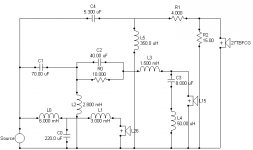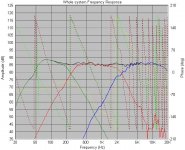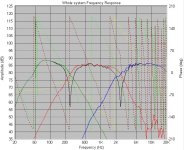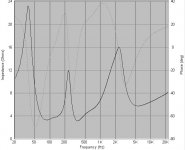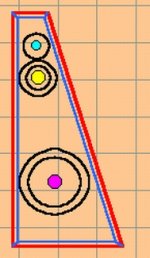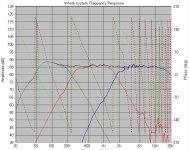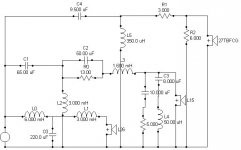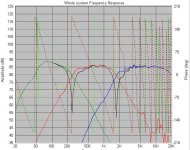The Resurrection - Seas L26 + L15 + 27TBFCG
Hi Rojah / Johan,
Thought I'd start a new thread for similar projects we are working on rather than threadjack this one:
Need help selecting a driver for my 3 way
I too am looking at an all metal 3 way. Using Seas drivers, I chose the L26 and 27TBFCG. I intend to go passive and have also got an L15 for the upper bass / midrange.
I know you are planning a L26/L18/27TBFCG, basing the mid/tweet crossover on Zaph's successful L18/27TBFCG.
I'm not sure I've picked a good mid for a true 3 way. The L15 is a bass/mid and the tweeter crossover point is limited to about 2KHz (or 2.5KHz depending on who you read) due to breakup (at about 8KHz).
I'll post some baffle simulations here and crossover ideas. Would be good if you don't mind sharing your approach. We might even have a couple of metal 3 ways for people to choose at the end of it (which seems to be lacking in the DIY area - at least ones that use a 10" woofer).
Cheers,
DAvid.
Hi Rojah / Johan,
Thought I'd start a new thread for similar projects we are working on rather than threadjack this one:
Need help selecting a driver for my 3 way
I too am looking at an all metal 3 way. Using Seas drivers, I chose the L26 and 27TBFCG. I intend to go passive and have also got an L15 for the upper bass / midrange.
I know you are planning a L26/L18/27TBFCG, basing the mid/tweet crossover on Zaph's successful L18/27TBFCG.
I'm not sure I've picked a good mid for a true 3 way. The L15 is a bass/mid and the tweeter crossover point is limited to about 2KHz (or 2.5KHz depending on who you read) due to breakup (at about 8KHz).
I'll post some baffle simulations here and crossover ideas. Would be good if you don't mind sharing your approach. We might even have a couple of metal 3 ways for people to choose at the end of it (which seems to be lacking in the DIY area - at least ones that use a 10" woofer).
Cheers,
DAvid.
Last edited:
It's a slow moving project...
Here's a candidate crossover simulation and modeled on-axis (and reverse null) response.
Cavaets:
These are re-used driver measurements with simulated baffle diffraction added in
HBT generated phase using -1.018 and -7.677 inches for L15 and L26 offset respectively
SpeakerWorkshop used for crossover modeling
First the crossover:
Here's a candidate crossover simulation and modeled on-axis (and reverse null) response.
Cavaets:
These are re-used driver measurements with simulated baffle diffraction added in
HBT generated phase using -1.018 and -7.677 inches for L15 and L26 offset respectively
SpeakerWorkshop used for crossover modeling
First the crossover:
Attachments
I've aimed for 4th order acoustic slopes. Reason being - kill the resonances of the metal cone drivers - 4KHz and approx 8Khz for the L26 and L15 (respectively). Crossover points are 240Hz and 2400Hz.
I'd like to cross the L15 lower to the tweeter (say 2KHz) and eliminate as much 2nd / 3rd order distortion as possible.
I'd like to cross the L15 lower to the tweeter (say 2KHz) and eliminate as much 2nd / 3rd order distortion as possible.
Attachments
Dave Bullet said:- normally all 3 drivers are in phase (which seems odd to me).
Hi, perfectly normal, not odd, for 4th order acoustic slopes,
Thanks sreten. Good to know. I just haven't seen a 3-way where all 3 drivers are wired with the same polarity so assumed I must have done something wrong (well, I probably have somewhere!).
Although 14 components aren't bad for a passive 3 way crossover (esp. considering metal drivers are used and cone breakups must be dealt with), it will be expensive. I will try and rationalise it down. I'll also include a padding option of the upper mid / treble response for bright rooms.
baffle simulation to be posted...
Although 14 components aren't bad for a passive 3 way crossover (esp. considering metal drivers are used and cone breakups must be dealt with), it will be expensive. I will try and rationalise it down. I'll also include a padding option of the upper mid / treble response for bright rooms.
baffle simulation to be posted...
Let say alot of cheap 3 ways are probably 2nd order acoustic slope... so that means 2nd driver out of phase. Also alot of exotic designs are built with as few crossover components as possible, because for that kind of designers, less is more.
2nd order = 180° out of phase, so reverse polarity on the center driver and it's back in phase.
4th order = 360° out of phase, but 360° = 0°, it's a full turn, so you're back in phase, all drivers need to have same polarity.
2nd order = 180° out of phase, so reverse polarity on the center driver and it's back in phase.
4th order = 360° out of phase, but 360° = 0°, it's a full turn, so you're back in phase, all drivers need to have same polarity.
I suppose that for most 3 ways 4th order acoustic bass to mid
I really struggled with getting good phase tracking with 2nd order acoustic between woofer / mid (a bit beyond my design capabilities... ), so resorted to 4th order.
I will try again since I would like to minimise the parts count.
I wasn't happy with a 2.4KHz xo point with the L15. The breakup is 8KHz and I wanted to be 2 octaves clear of it.
I've modified the crossover and got a smoother response that has even better phase integration and brought the tweeter level down. However - I feel it might be a little too low now (1725Hz). Although 4th order acoustic has been maintained on the tweeter and it is only 5dB higher through the mid stopband than the previous version.
Thanks,
David.
Here's the BDS geometry for the drivers.
My current enclosure plans:
L15 - large sealed (although EBP indicates vented might be better). I want to minimise midrange leakage out any port (by not having one). Problem with a sealed mid is backwave effects on the cone. I plan to mitigate this by a sloped internal divider (from the woofer cavity) to reflect the waves "up" and reasonable damping material. volume TBD
L26 - ported. Want to minimise excursion over a larger FR range. It's not about bass extension. I believe the 2 L26 sealed should get me into the 40's (in room). These aren't for HT / explosions.
My current enclosure plans:
L15 - large sealed (although EBP indicates vented might be better). I want to minimise midrange leakage out any port (by not having one). Problem with a sealed mid is backwave effects on the cone. I plan to mitigate this by a sloped internal divider (from the woofer cavity) to reflect the waves "up" and reasonable damping material. volume TBD
L26 - ported. Want to minimise excursion over a larger FR range. It's not about bass extension. I believe the 2 L26 sealed should get me into the 40's (in room). These aren't for HT / explosions.
Attachments
Here's the BDS ripple.
Reason for the odd enclosure shape above:
a) smoother BDS
b) asthetics (not another boring rectangle)
c) imaging (narrower for the mid / tweeter)
I don't yet know how bad floor bounce / cancellation will be with the L26's so close to the floor. Might have to do some sim work on that too.
Reason for the odd enclosure shape above:
a) smoother BDS
b) asthetics (not another boring rectangle)
c) imaging (narrower for the mid / tweeter)
I don't yet know how bad floor bounce / cancellation will be with the L26's so close to the floor. Might have to do some sim work on that too.
Attachments
Dave Bullet said:
..... However - I feel it might be a little too low now (1725Hz) .......
David.
Hi, see http://www.zaphaudio.com/BAMTM.html ,
Dave Bullet said:Hi Rojah / Johan,
Thought I'd start a new thread for similar projects we are working on rather than threadjack this one:
http://www.diyaudio.com/forums/showthread.php?s=&threadid=106560
I too am looking at an all metal 3 way. Using Seas drivers, I chose the L26 and 27TBFCG. I intend to go passive and have also got an L15 for the upper bass / midrange.
I know you are planning a L26/L18/27TBFCG, basing the mid/tweet crossover on Zaph's successful L18/27TBFCG.
I'm not sure I've picked a good mid for a true 3 way. The L15 is a bass/mid and the tweeter crossover point is limited to about 2KHz (or 2.5KHz depending on who you read) due to breakup (at about 8KHz).
I'll post some baffle simulations here and crossover ideas. Would be good if you don't mind sharing your approach. We might even have a couple of metal 3 ways for people to choose at the end of it (which seems to be lacking in the DIY area - at least ones that use a 10" woofer).
Cheers,
DAvid.
Oops... I missed this thread. I'm relatively new here, and I haven't made it a habbit to log in, yet. Perhaps I could start by telling a little about my thoughts regarding this all-metal 3-way project. Hope my english is understandable... Guess it all started when I bought the Acoustic Energy AE-1 loudspeakers many years ago. They were equipped with aluminium drivers (5" + 1"), and I still think they're one of the most musical satisfying loudspeakers I've heard.
I can't say exactly why, but I think the coherence and the "cleanness" of sound made them attractive to me. I could listen to music for hours without getting tired or bored. I find that to be an achivement since these speakers never screamed for attension. I also tried the AE-1 with a subwoofer and active low-pass filtering, and found it to be one of the most pleasing systems I've ever had.
At the moment I'm playing my music on KingSound Queen hybrid electrostats with EAR-Yoshino pre/power amps. I also have a pair of Hammer Dynamics Super 12s. Quite different approaches, I'd say. Although they have their strenghts, I end up missing the sound produced from the AE-1/subwoofer system. When I bought the DEQX, I realized that a 3-way system could be a good chance to go back again, and the 3-way SEAS all-metal system sounded interesting.
I'm not experienced in DIY and I've got a lot of work and learning to do. Thats the reason why I started reading about Zaphs design with L15/L18. Here I could get a lot of info and measurements from an experienced constructor, and I'm hoping it'll be possible to implement the L26 woofer in making a system with a bit more scale and effortlessness. Perhaps I'm a bit patriotic to, since SEAS is a norwegian manufacturer?
I'm still in the process of figuring out how the DEQX works and how I want to build this system. My reason for L18 is mainly because the 3-way system would be a "sub" + satellite-system with a low XO point, and perhaps the 6,5" driver would offer slightly more sensitivity and grunt towards the woofer? But I haven't decided yet. It might be a better choice to go with the L15 since the system don't need to play very loud and since I'll have enough power to get the wanted SPL. Thinking of building Hypex UcD-modules as amplification.
I really fancy your cabinet plans. Haven't decided if I want to build the system in a single enclosure, or separate woofer/satellite sections where the baffle would be from Zaphs L18/L15 design. I have to admit that I like the idea of a higher xo between woofer and mid. Perhaps using the L26 up to where the bafflestep begins, and the crossing over to a smaller midrange driver (perhaps the Seas L12 would be a nice match to?) This would perhaps make the baffle/driver-layout more sensitive?
Well, I've just decided to sell my valve preamp, and replace it with my DEQX. Hopefully I'll decide what design to apply, and I'll post the progress in this thread. Good luck to you, and your project. It will be interesting to read about your experiences with the 3-way all-metal system.
Regards
Johan
Hi Johan,
Good to see you call by. One of the benefits as you no doubt know of a smaller diameter driver is better off-axis dispersion, hence my choice for the L15. My only concern is harmonic distortion of the driver. I would "hope" that it would follow a similar profile to the L18.
I too am intrigued by metal drivers, hence thought why not choose something impossible for a new DIYer... Do a 3 way..... with metal drivers with nasty breakup modes!
The cabinet design is intended to give a narrow baffle to the mid/tweeter for better imaging, yet still be big enough to fit the 10" L26. Another advantage is having a non-parallel side to reduce standing waves. The L26 has to fire forward as I want to run it up past 100Hz (side-firing the L26 would cause a nasty variation in the power response).
I don't like the look of sealed box woofer plus open baffle mid/tweeter designs. To me they look unfinished, like someone built the box too small then slapped the mid/tweeter on top. Hence, why I'm shooting for a sloped cabinet.
I will finish it in some native timber over MDF. Still in the modeling stages, yet to break in the drivers.
Even though you may be going the digital way for the crossover, there's still a lot of overlap and much we could share about the designs.
I'll post here as I progress the project. Next up is some enclosure modeling for the L26. I'm leaning back toward a sealed box (classic 0.71 Q - around 47 litres). The L15 will be sealed too - but in a large enclosure (close to 0.5 Q). The other option for the L26 would be 90 L ported, giving an F3= 26Hz. The sealed 47L would give an F3 about 42Hz which is still respectable.
Keep in touch.
Dave.
Good to see you call by. One of the benefits as you no doubt know of a smaller diameter driver is better off-axis dispersion, hence my choice for the L15. My only concern is harmonic distortion of the driver. I would "hope" that it would follow a similar profile to the L18.
I too am intrigued by metal drivers, hence thought why not choose something impossible for a new DIYer... Do a 3 way..... with metal drivers with nasty breakup modes!
The cabinet design is intended to give a narrow baffle to the mid/tweeter for better imaging, yet still be big enough to fit the 10" L26. Another advantage is having a non-parallel side to reduce standing waves. The L26 has to fire forward as I want to run it up past 100Hz (side-firing the L26 would cause a nasty variation in the power response).
I don't like the look of sealed box woofer plus open baffle mid/tweeter designs. To me they look unfinished, like someone built the box too small then slapped the mid/tweeter on top. Hence, why I'm shooting for a sloped cabinet.
I will finish it in some native timber over MDF. Still in the modeling stages, yet to break in the drivers.
Even though you may be going the digital way for the crossover, there's still a lot of overlap and much we could share about the designs.
I'll post here as I progress the project. Next up is some enclosure modeling for the L26. I'm leaning back toward a sealed box (classic 0.71 Q - around 47 litres). The L15 will be sealed too - but in a large enclosure (close to 0.5 Q). The other option for the L26 would be 90 L ported, giving an F3= 26Hz. The sealed 47L would give an F3 about 42Hz which is still respectable.
Keep in touch.
Dave.
Hello again.
Have done some thinking about the speakerproject this weekend. I agree that a single enclosure probably would be better looking in a normal livingroom. My "problem" is that I have the hybrid electrostats with their small woofers (5,5"), and I'm very curious how they would sound with a good "sub"woofer-section. Because of that, I'm probably going to build the system in separate housings which enables me to use the woofer-section in both systems. One solution could be to split the cabinet i two, but keep the angle as in your design.
I also agree that using the L15 would be a better choise for midrange-radiation and coherence in the midband. I notice that Troels Gravesen didn't have much to complain about the Exel-equivalent used as mid-driver in his PMS-Exel 3-way design. Probably a "good-enough" solution. I guess the sensitivity of the L26 will be quite low anyway, so it looks to be a sensible compromise compared to the L18.
My main concern is the need for volume by using L26 i a reflexloaded enclosure. I don't want the woofer-system to exceed 70 liters or so. I also notice that Seas recommends closed cabinet, but I think I'll try the L26 in a 70L BR, and se how it turns out. I still have a pair 100L enclosures left from my past subwoofer-project (using Beyma 15"), and could try them in there.
Think I'm going to place an order for the drivers today, and hopefully start building the cabinets soon.
Regards
Johan
Have done some thinking about the speakerproject this weekend. I agree that a single enclosure probably would be better looking in a normal livingroom. My "problem" is that I have the hybrid electrostats with their small woofers (5,5"), and I'm very curious how they would sound with a good "sub"woofer-section. Because of that, I'm probably going to build the system in separate housings which enables me to use the woofer-section in both systems. One solution could be to split the cabinet i two, but keep the angle as in your design.
I also agree that using the L15 would be a better choise for midrange-radiation and coherence in the midband. I notice that Troels Gravesen didn't have much to complain about the Exel-equivalent used as mid-driver in his PMS-Exel 3-way design. Probably a "good-enough" solution. I guess the sensitivity of the L26 will be quite low anyway, so it looks to be a sensible compromise compared to the L18.
My main concern is the need for volume by using L26 i a reflexloaded enclosure. I don't want the woofer-system to exceed 70 liters or so. I also notice that Seas recommends closed cabinet, but I think I'll try the L26 in a 70L BR, and se how it turns out. I still have a pair 100L enclosures left from my past subwoofer-project (using Beyma 15"), and could try them in there.
Think I'm going to place an order for the drivers today, and hopefully start building the cabinets soon.
Regards
Johan
- Status
- This old topic is closed. If you want to reopen this topic, contact a moderator using the "Report Post" button.
- Home
- Loudspeakers
- Multi-Way
- Calling Johan - Seas L26 + L18/L15 + 27TBFCG
